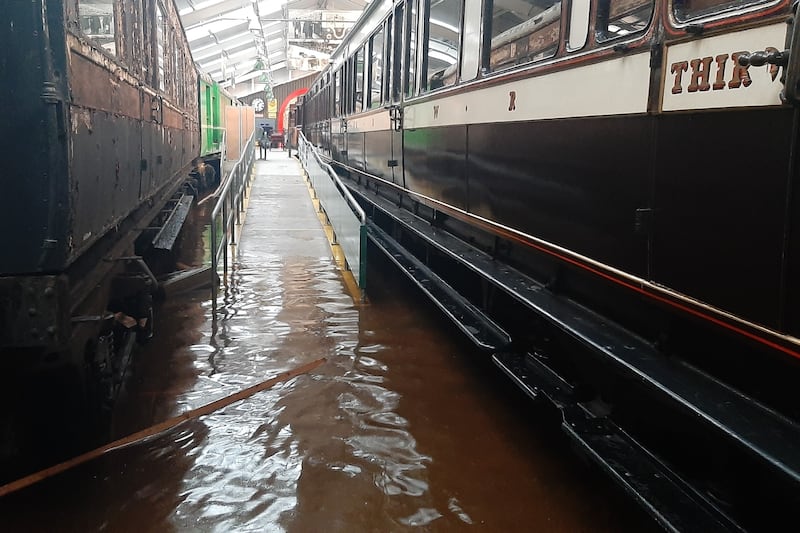The railways of Northern Ireland, like much of the rest of the island, are a shadow of their former selves.
Where it was once possible to travel from Dublin to Donegal via Enniskillen, or along the old Derry Road through Tyrone via Omagh, a much leaner network is operated by Translink in 2024.
Rail connectivity was once so widespread, Down boasted its own main line network linking almost all parts of the county to Belfast and the coast.
The Belfast & County Down Railway (BCDR) came into being in August 1848, when the first section opened to passengers between Belfast and Holywood. Over time, its rails spread, from Bangor and Donaghadee on one coastline right down to Ardglass and Newcastle on the other.
Like all places where railways reached, it quickly became a fixture of daily life and a great source of employment. A 2008 BBC TV documentary features interviews with former BCDR workers. These men recall their days on the rails with a small glint still in their eyes.
One recounts the secrecy around the movement of troop trains carrying US soldiers during the second World War, on the same day he found a train guard “flat out drunk” on the platform at Ballykinlar Halt after the train arrived. Maybe recruiting off-duty railway workers from the local pubs at the last minute to man these secret trains was not the best idea.
Another man tells of the day he went for his examination to become a fireman on the old steam trains used on the network and keeping himself fed on the job. These men were wholeheartedly dedicated to their work, even to the point where they cooked their fry-ups on the shovels they used to throw coal on the fire.
“I got the soda bread, the tatty bread, the bacon and the eggs and a bit of lard ... got my shovel ... and I did a lovely fry.”
The end of the BCDR came in 1948 with the formation of the Ulster Transport Authority. Survival against cheaper and more convenient road transport was a losing game.
Thankfully, part of the old network survives as the volunteer-run Downpatrick & County Down Railway (DCDR). The line to Downpatrick closed in 1950 and the DCDR was set up in 1985 to restore it. For decades, the railway has operated for the public using heritage diesel and steam trains as the island’s only full-size heritage line. The trains usually run on a triangle, from Downpatrick to Inch Abbey across to the old loop-line platform.
Today, however, the DCDR is fighting back after some of the worst flooding to hit Northern Ireland in living memory struck last year. Parts of the town were left up to a metre in water, including much of the railway’s station, workshops and carriage gallery building. The line was subsequently forced to cancel its Santa Train events at Christmas.
“The big process since November has been drying everything out ... it’s all the invisible damage that has really taken its toll on us,” DCDR chairman Robert Gardiner said.
A group of roughly a dozen volunteers has been working to bring the railway back into service, fixing everything from engines to track, coaches and buildings.
“The biggest challenge for us is rolling stock. Basically the water got up about 3ft high ... everything got immersed in water,” Gardiner said.
“There was a huge amount of shock when it first happened – the emotional toll its taken [on the volunteers] is immense.”

All rolling stock is still being thoroughly assessed or tested. Unfortunately, this work does not come cheap, even with free labour. While work continues to get the line back up and running after the floods, no trains have been able to run since last year.
Gardiner said the railway needs to raise £250,000 to fully recover. A movie night with a screening of the 1937 Will Hay film Oh, Mr Porter, a comedy set on a fictitious rural railway in the North, was held in February to great local reception and further fundraising events are planned.
Another recent boost for the railway came in the form of their very own Jonathan King winning Young Volunteer of the Year at the UK Heritage Railway Association’s annual awards. The Trinity student was pitted against other young people from across the UK but earned the accolade in part due to his response to the flooding, being able to check on the railway site and help elsewhere in the town as the waters flowed in as he lives locally, Gardiner said.
As the railway continues to rebuild, Gardiner is confident they will be able to run some form of train service at some point this summer.
“There are rays of sunshine ... the DCDR is not gone.”
Donations can be made to the DCDR’s flood recovery appeal online at downrail.co.uk/appeal















